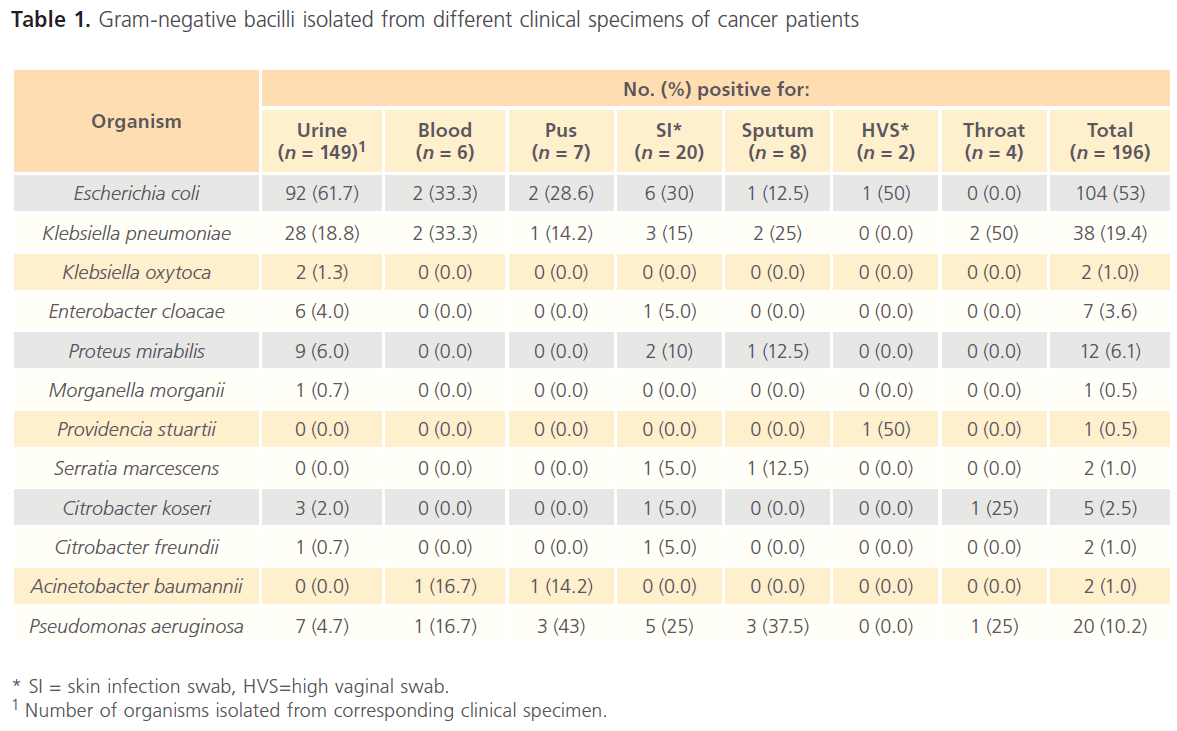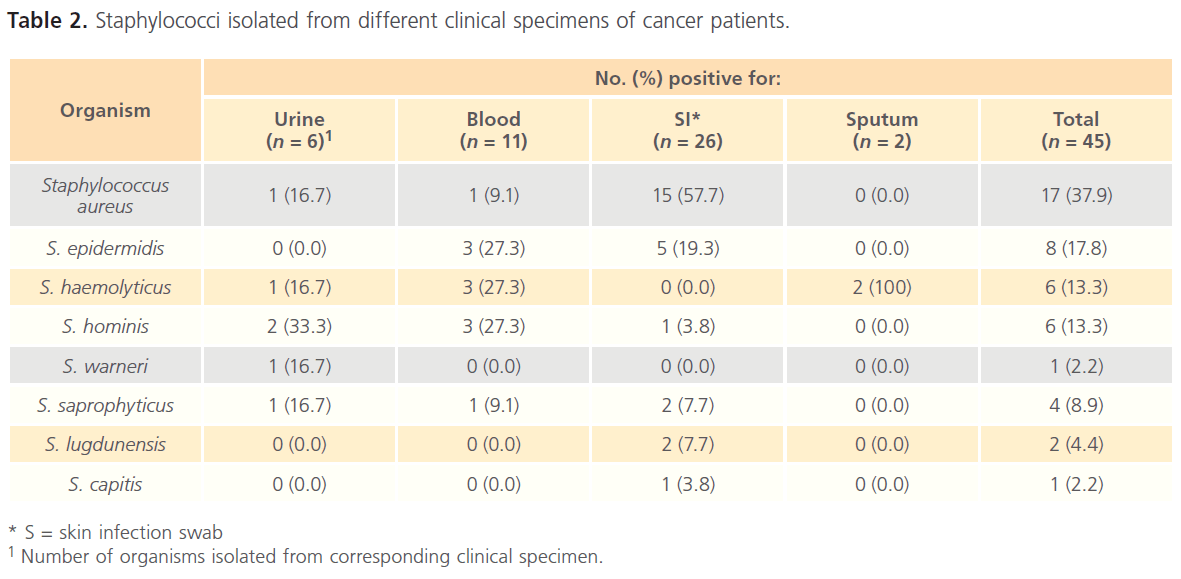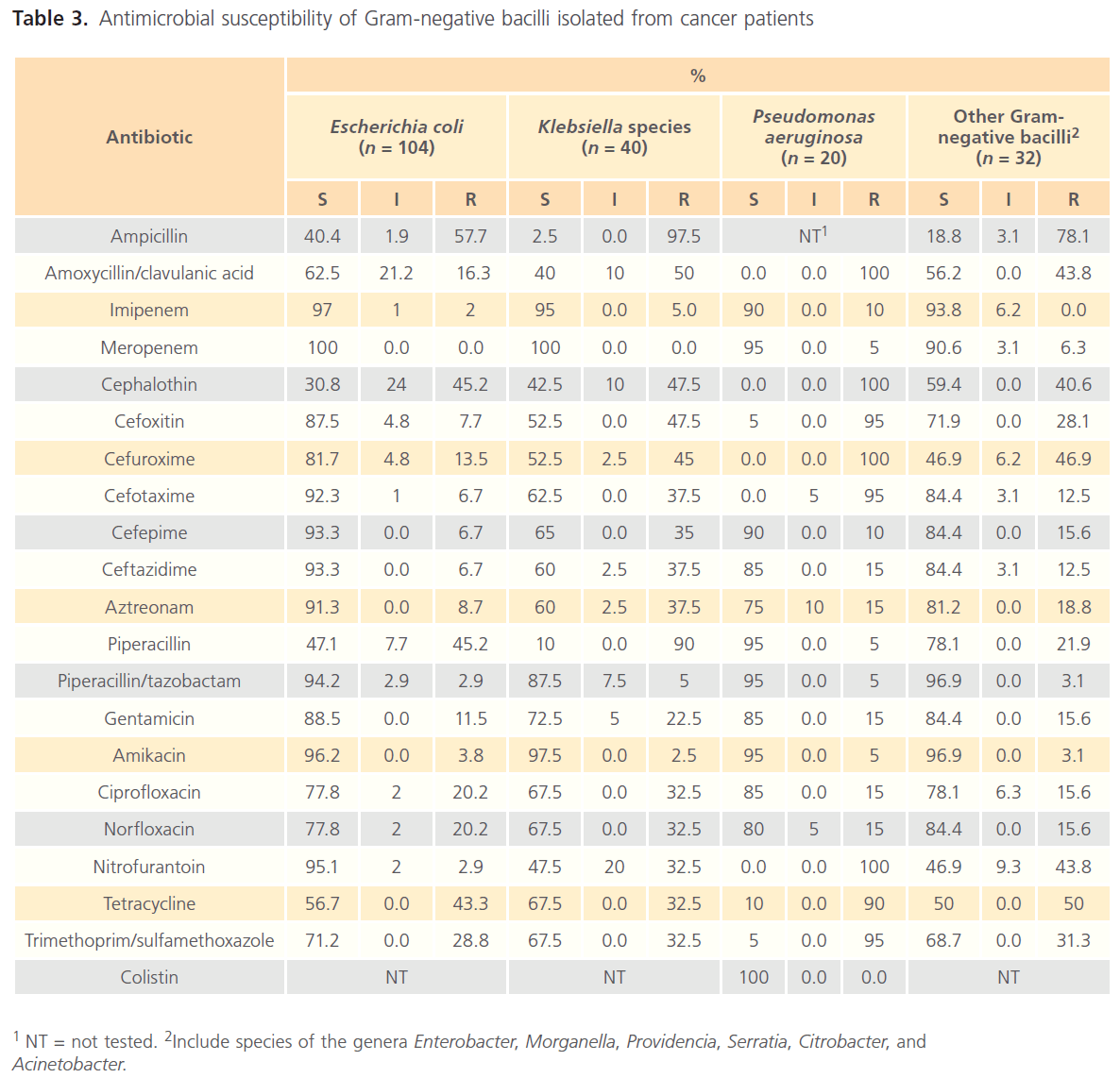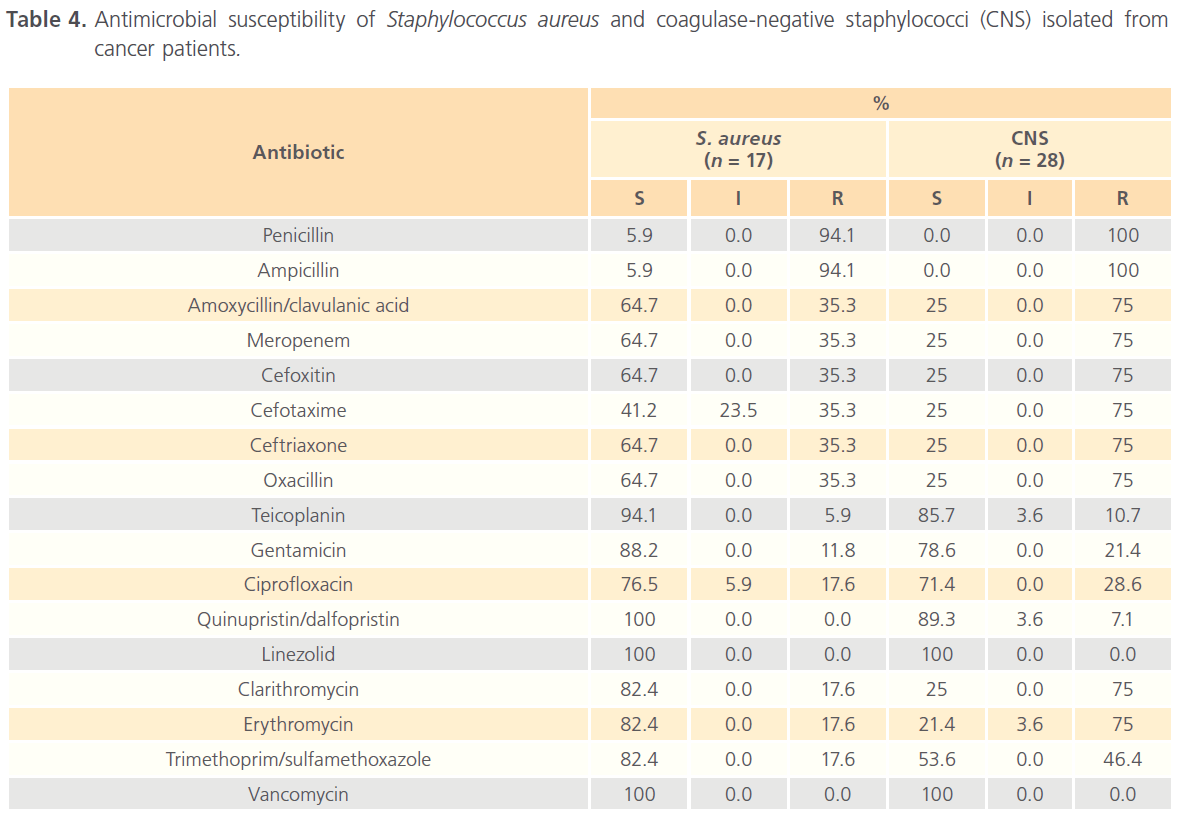Key words
Antimicrobial resistance, Gram-negative bacilli, Gram-positive cocci, cancer, Libya
Introduction
Due to defects in their immunity cancer patients particularly those with profound and prolonged neutropenia are prone to serious infections with substantial morbidity and mortality [1,2]. Most infections in cancer patients are nosocomial in nature as a result of their prolonged and frequent contact with hospital environment [3]. In many institutions in developed countries, more Gram-positive bacteria, mainly staphylococci, than Gram-negative bacteria are isolated from cancer patients [4-6]. Use of indwelling catheters, oral mucositis, and prophylactic and empirical treatment directed mainly against Gram-negative bacteria are reasons, among others, that have been given for this phenomenon [7]. Emergence of antimicrobial resistance among staphylococci (e.g. methicillinresistant S. aureus [MRSA]) and Gram-negative bacilli (e.g. fluoroquinolone-resistant Escherichia coli [FREC]) associated with infections in cancer patients is of particular concern in recent years. Reports on the microbial spectrum and antimicrobial resistance profiles of bacteria from cancer patients in the countries of North Africa are rare and such reports from Libya are lacking. The aim of this study was to determine the profile and susceptibility patterns of bacterial pathogens associated with infections in cancer patients attending the African Oncology Center (AOC) in Sabrata city, Libya.
Materials and Methods
Included in the present study 256 bacterial isolates (196 aerobic and facultative anaerobic Gram-negative bacilli [GNB] and 60 Gram-positive cocci [GPC]) isolated from patients with hematologic malignancies and solid tumors treated at the African Oncology Institute (AOC) in Sabrata, Libya between January and December 2009. The patients aged 1 to 97 years (mean=40.5 yrs) with female to male ratio 2:1. AOC is a 130 bed hospital that provides free medical care for cancer patients from all regions of Libya.
Organisms were isolated from sputum, throat swabs, skin infection swabs (SI), high vaginal swabs (HVS), urine and blood specimens from the patients at the time an infection occurred. All specimens were cultured on different media accordingly using standard bacteriological procedures [8]. Isolated organisms were identified to the species level and tested for their susceptibility to a variety of antimicrobial agents by the BD Phoenix Automated Microbiology System (PAMS, MSBD Biosciences, Sparks Md, USA) according to the manufacturer’s instructions. The PAMS uses combination panels for identification (ID) and antimicrobial susceptibility testing (AST) of bacteria. These include the Phoenix™ NMIC/ID Panels intended for the in vitro rapid ID and AST by minimal inhibitory concentration (MIC) of Gram-negative aerobic and facultative anaerobic bacteria from pure culture belonging to the family Enterobacteriaceae and non-Enterobacteriaceae; the Phoenix™ PMIC/ID Panels intended for the in vitro rapid ID and AST of Gram-positive bacteria belonging to the genera Staphylococcus, Enterococcus, and other Gram-positive cocci and Gram-positive bacilli; and the Phoenix™ SMIC/ID Panels intended for the in vitro rapid ID and AST of bacteria belonging to the genera Streptococcus. PAMS provides AST results for antimicrobials as susceptible (S), intermediate susceptible (I) and resistant (R) and is interpreted according to CLSI criteria [9].
The following quality control strains were tested with each run according to the type of bacteria examined: E. coli ATCC 25922, E. coli ATCC 35218, K. pneumoniae ATCC 700603 and Ps. aeruginosa ATCC 27853 with GNB; S. aureus ATCC 29213, S. aureus ATCC 25923, E. faecalis ATCC 29212 and E. faecalis ATCC 51299 with Staphylococcus and Enterococcus; and Strep. agalactiae ATCC 13813 and Strep. pneumoniae ATCC 49619 with Streptococcus.
All oxacillin-resistant S. aureus (MRSA) and oxacillin-resistant coagulase-negative staphylococci (MRCNS) isolates were tested for mecA gene by PCR as previously reported [10]. Only the first isolate from each patient was included in this study. Patients were informed of the purpose of the study and their consent was obtained before specimen collection.
Results
Of the 196 GNB isolates examined 76% were from urine specimens. The predominant organisms were Escherichia coli (53%), Klebsiella pneumoniae (19.4%) and Pseudomonas aeruginosa (10.2%). Table 1 shows the distribution of GNB isolated from different clinical specimens of cancer patients.

*SI = skin infection swab, HVS=high vaginal swab.
1Number of organisms isolated from corresponding clinical specimen.
Table 1: Gram-negative bacilli isolated from different clinical specimens of cancer patients
Of the investigated GPC, 28 (46.7%) were identified as coagulase- negative staphylococci (CNS), 17 (28.3%) S. aureus, 5 (8.3%) enterococci and 10 (16.7%) streptococci. Speciation of CNS strains showed the predominance of S. epidermidis, S. hominis and S. haemolyticus. Table 2 shows the distribution of staphylococci isolated from different clinical specimens of cancer patients.

*S = skin infection swab
1Number of organisms isolated from corresponding clinical specimen.
Table 2: Staphylococci isolated from different clinical specimens of cancer patients.
Two (40%) of the enterococci isolates were from urine, 2 (40%) from SI and one (20%) from HVS specimens. All Enterococcus isolates were identified as E. faecalis. Most (40%) of the streptococci isolates were from HVS. Seven of the Streptococcus isolates were identified as Strep. agalactiae (also known as groups B Streptococcus [GBS]) and the remaining three as Strep. acidominimus.
High resistance rates were observed among total GNB to ampicillin (73.1%), amoxycillin-clavulanic acid (36.2%), piperacillin (46.4%), tetracycline (46.9%) and trimethoprim-sulfamethoxazole (36.7%). On the other hand, low resistance rates were detected for imipenem (3.1%), meropenem (1.5%), piperacillin/tazobactam (3.6%), amikacin (3.6%), and colistin (2.6%). Of the three most common isolated GNB, Ps. aeruginosa strains showed extremely high rates of resistance to cephalothin (100%), cefoxitin (95%), cefuroxime (100%) and cefotxime (95%), tetracycline (90%) and trimethoprim/sulfamethoxazole (95%). MDR was observed in 95% of Ps. aeruginosa strains examined. Susceptibility of GNB isolated from cancer patients to antimicrobial agents is shown in Table 3.

1NT = not tested.
2Include species of the genera Enterobacter, Morganella, Providencia, Serratia, Citrobacter, and Acinetobacter.
Table 3: Antimicrobial susceptibility of Gram-negative bacilli isolated from cancer patients
Extended spectrum b-lactamases (ESBLs) were detected in 7 (6.7%) of E. coli and in 13 (32.5%) of Klebsiella spp. isolates. Of the ESBL-positive strains 14 (70%) were from urine, and 2 (10%) each from blood, pus and skin specimens.
The staphylococci examined showed high resistance rates to the b-lactam drugs ranging between 60 to100 percent. Oxacillin resistance was detected in 6 (35.3%) S. aureus (MRSA) and in 21 (75%) CNS (MRCNS). All oxacillin-resistant staphylococci were positive for the mecA gene by PCR. None of the staphylococci examined were resistant to linezolid or to vancomycin. Table 4 shows the susceptibility of S. aureus and CNS isolated from cancer patients to antimicrobial agents.

Table 4: Antimicrobial susceptibility of Staphylococcus aureus and coagulase-negative staphylococci (CNS) isolated from cancer patients.
Resistance to b-lactam drugs, gentamicin, and trimethoprimsulfamethoxazole was observed in 100% and to erythromycin in 60% of E. faecalis isolates. In addition, one E. faecalis isolates (from SI) was also resistant to linezolid (LRE), teicoplanin, and ciprofloxacin.
All (100%) streptococci isolates were susceptible to meropenem, cefotaxime, ceftriaxone, cefepime, vancomycin and linezolid. Only one (10%) Strep. agalactiae isolate was resistant to penicillin, amoxycillin-clavulanic acid, ciprofloxacin, and clarithromycin. Furthermore, resistance to erythromycin and tetracycline was observed in 3 (30%) and 7 (70%) streptococci isolates, respectively.
Discussion
Identification and determination of antimicrobial susceptibility of bacterial pathogens can aid the clinician in selecting the appropriate antimicrobial agent (s) to treat his patients. Prabhash et al., in India, reported the predominance of Pseudomonas spp., followed by Acinetobacter spp. and E. coli among GNB isolated from blood stream infections (BSI) in cancer patients [11]. In the present study, E. coli, followed by K. pneumoniae and Ps. aeruginosa were the most common GNB identified. It should be noted that most of GNB strains examined were from urine specimens. This may explain the predominance of E. coli and K. pneumoniae amongst our GNB isolates. Ashour and El-Sharif, in Egypt, reported similar findings [12]. They found that GNB causing UTIs in both leukemic and solid-tumor patients were mainly E. coli and K. pneumoniae. Contrary to recent reports from developed countries, our findings and those reported by other investigators [11,12] indicate that GNB are the predominant organisms associated with infections in cancer patients in developing countries. This observation may have important implications in selecting the appropriate treatment for such patients.
Infections due to GNB with high resistance rates to b-lactam and non-b-lactam drugs are common in cancer patients [13,14]. Similarly, our GNB isolates showed high resistance rates to different classes of antimicrobials, particularly among Ps. aeruginosa isolates with 95% of them being multidrug resistant. However, high susceptibility (< 4% resistance) rates were observed among the examined GNB isolates to imipenem, meropenem, piperacillin/tazobactam, amikacin. Nejad et al., in Iran, reported multidrug resistance in 37% and 33% of E. coli and Klebsiella spp. from cancer patients [14]. We observed lower rate of multidrug resistance for E. coli (29%) and similar rate for Klebsiella spp. (33%).
A study from neighboring Egypt reported high resistance rates to fluoroquinolones in E. coli (> 55%) and K. pneumoniae (> 30%) from cancer patients [12]. Resistance to fluoroquinolones (ciprofloxacin and norfloxacin) was observed in 20.2%, 32.5% and 15% of E. coli, Klebsiella spp. and Ps. aeruginosa from Libyan cancer patients, respectively. In many centers, fluoroquinolones are routinely used for prophylaxis in cancer patients [15]. Such clinical practice may have contributed to the observed high resistance rates against fluoroquinolones among GNB isolated from patients with cancer. Recently, Cattaneo et al. [13] reported very high rates of resistance (86.8%) to the fluoroquinolone levofloxacin among E. coli from patients with hematological malignancies. These investigators, using multivariate analysis, identified prophylaxis and neutropenia > 7 days as independent risk factors for fluoroquinolone resistance.
The emergence of resistance to b-lactam drugs due to the production of type 1 and extended-spectrum b-lactamases (ESBLs) among E. coli and other Enterobacteriaceae is of great concern [1]. Reports on the prevalence of ESBLs among GNB in cancer patients from the North Africa region are rare. In this investigation ESBLs were detected at 6.7% and 32.5% among E. coli and Klebsiella spp. isolates. Higher rates (> 80%) for ESBLs among GNB from cancer patients were reported from India [16].
In many cancer centers staphylococci, mainly the coagulasenegative (CNS), are the most commonly isolated bacteria, particularly from bacteremic patients [4,17]. In the present study CNS were the most common staphylococci isolated from cancer patients in AOC with predominance of S. epidermidis. Others reported closely similar findings [18].
Several studies reported very high rates of methicillin resistance among S. aureus (> 81%) as well as CNS (> 90%) from cancer patients [4,18]. In the present investigation all oxacillin-resistant staphylococci were positive for the mecA gene by PCR. Although lower rates for MRSA (35%) and MRCNS (75%) were found among our patients compared with the previously mentioned studies, such rates remain high. The high MRSA rates could be the result of wide use of fluoroquinolones and other antimicrobials for treatment and prophylaxis of bacterial infections in cancer patients [19,20].
Recently, Ashour and El-Sharif investigated the antibiotic susceptibility profile of Gram-positive aerobic bacteria isolated from Egyptian cancer patients [18]. They reported that more than 15% of S. aureus were resistant to linezolid and vancomycin and 11% of CNS were vancomycin resistant. Fortunately, none of the staphylococci examined in the present study were resistant to linezolid or to vancomycin. Furthermore, teicoplanin and quinupristin/dalfopristin showed excellent activity against MRSA (94.1 ad 100%, respectively) and MRCNS (85.7 and 89.3%, respectively) and can be used for the treatment of these organisms in cancer patients at AOC.
Members of the genus Enterococcus, mainly the species faecium and faecalis, are important nosocomial pathogens. A recent report by the National Nosocomial Infections Surveillance (NNIS) System in the USA indicated that vancomycin-resistant enterococci (VRE) account for nearly 30% of all enterococci isolated from patients infected in ICUs [21]. None of our enterococci isolates were resistant to vancomycin. However, we detected one E. faecalis isolate resistant to linezolid (LRE). To our knowledge this is the first report of LRE from Libya.
The viridans streptococci (a-haemolytic streptococci) are the predominant streptococci isolated from patients with cancer [18,22]. In the present study, only 3 of the 10 isolated streptococci were of the viridians group and identified as Strep. acidominimus. There are few reports on the association of Strep. acidominimus with infection in cancer patients. Recently, Dalal and Urban reported the isolation of Strep. acidominimus from the blood sample of 76-year-old man with lung cancer, who presented to the emergency room with a 2-day history of productive cough and fever [23]. Group B Streptococcus usually causes no symptoms in healthy adults; however patients with malignancies are at increased risk of infection with this organism [24,25].
In accordance with previous reports [25], none of our streptococci isolates were resistant to 3rd cephalosporins, vancomycin or linezolid. However, we found one (14.3%) Strep. agalactiae isolate resistant to penicillin and ciprofloxacin. Fluoroquinolone resistance in GBS (FR-GBS) is uncommon. Previous studies reported rates of FR-GBS ranging between 1.2 to 5% [26-28]. Recently, Wehbeh et al. reported FR-GBS isolated from 23 patients with multiple comorbid conditions, including, among others, carcinoma, and diabetes mellitus [27]. There are no reports from Libya on FR-GBS.
In conclusion, contrary to recent reports from developed countries GNB are the predominant organisms associated with infections in cancer patient in AOC. High resistance rates against most of the antimicrobials tested were observed among the organisms examined, particularly among Ps. aeruginosa and CNS isolates. Excellent activity was observed by amikacin and the carbapenems imipenem and meropenem against GNB and by linezolid, teicoplanin, quinupristin/dalfopristin and vancomycin against GPC. Observed high rates of MRSA and MRCNS and the emergence of LRE and FR-GBS in the population studied is of concern. In addition, a comprehensive infection control program should be implemented that include raising awareness of the importance of good hand hygiene among health care workers to help prevent the spread of MDR bacteria to cancer patients treated at AOC.
152
References
- Rolston KVI, Bodey GP (2000) Infections in patient with cancer. In: Bast CR, Kufe DW, Pollock RE, Weichselbaum RR, Holland JF, Frei E (Eds.): Cancer Medicine, 5thEd. Hamilton-London: B.C. Decher Inc. pp.2407-2432.
- Safdar A, Armstrong D (2001) Infectious morbidity in critically ill patients with cancer. Crit Care Clin 17: 531-570.
- Kurtaran B, Candevir A, Tasova Y, Kibar F, Inal AS, et al. (2010) Hospital-acquired bloodstream infections in cancer patients between 2005 and 2007 in a Turkish university hospital. Arch ClinMicrobiol 1:2. doi: 10:3823/205 (https://www.acmicrob.com).
- Morris PG, Hassan T, McNamara M, Hassan A, Wiig R, et al. (2008) Emergence of MRSA in positive blood cultures from patients with febrile neutropenia-a cause for concern. Support Care Cancer 16: 1085-1088.
- Rolston KVI, Yadegarynia D, Kontoyiannis DP, Raad II, Ho DH (2006) The spectrum of gram-positive bloodstream infections in patients with hematologic malignancies, and the in vitro activity of various quinolones against gram-positive bacteria isolated from cancer patient. Int J Infect Dis 10: 223-230.
- Safdar A, Rodriguez GH, Balakrishnan M, Tarrand JJ, Rolston KVI (2006) Changing trends in etiology of bacteremia in patients with cancer. Eur J ClinMicrobiol Infect Dis 25: 522-526.
- Klastersky J, Aoun M (2004) Opportunistic infections in patients with cancer. Ann Oncol 15(Suppl.): 329–335.
- Koneman EW, Allen SD, Janda WM, Schreckenberger PC, Winn WC Jr (1997) Color Atlas and Textbook of Diagnostic Microbiology, 5th edn. Philadelphia: Lippincott.
- Clinical and Laboratory Standards Institute (CLSI) (2009) Methods for Dilution Antimicrobial Susceptibility Tests for Bacteria That Grow Aerobically; Approved Standard-Eighth Edition (M07-A8).
- Zorgani A, Elahmer O, Franka E, Grera A, Abudher A, Ghenghesh KS (2009) Detection of methicillin-resistant Staphylococcus aureusamong healthcare workers in Libyan hospitals. J Hosp Infect 73: 91-92.
- Prabhash K, Medhekar A, Ghadyalpatil N, Noronha V, Biswas S, et al. (2010) Blood stream infections in cancer patients: A single center experience of isolates and sensitivity pattern. Indian J Cancer 47: 184- 188.
- Ashour HA, El-Sharif A (2009) Species distribution and antimicrobial susceptibility of gram-negative aerobic bacteria in hospitalized cancer patients. J Transl Med 7:14. doi:10.1186/1479-5876-7-14 (https://www. translational-medicine.com/ content/7/1/14).
- Cattaneo C, Quaresmini G, Casari S, Capucci MA, Micheletti M, et al. (2008) Recent changes in bacterial epidemiology and the emergence of fluoroquinolone-resistant Escherichia coli among patients with haematological malignancies: results of a prospective study on 823 patients at a single institution. J AntimicrobChemother 61: 721-728
- Nejad ZE, Ghafouri E, Farahmandi-Nia Z, Kalantari B, Saffari F (2010) Isolation, identification, and profile of antibiotic resistance of bacteria in patients with cancer. Iran J Med Sci 35: 109-115.
- Maschmeyer G, Haas A (2008) The epidemiology and treatment of infections in cancer patients. Int J Antimicrob Agents 31: 193-197.
- Gupta A, Singh M, Singh H, Kumar L, Sharma A, et al. (2010) Infections in acute myeloid leukemia: an analysis of 382 febrile Episodes. Med Oncol 27: 1037-1045.
- El-Mahallawya H, Sidhoma I, Ali El-Dinb NH, Zamzama M, El-Lamie MM (2005) Clinical and microbiologic determinants of serious bloodstream infections in Egyptian pediatric cancer patients: a one-year study. Int J Infect Dis 9: 43-51.
- Ashour HM, El-Sharif A (2007) Microbial spectrum and antibiotic susceptibility profile of Gram-positive aerobic bacteria isolated from cancer patients. J ClinOncol 25: 5763-5769.
- LeBlanc L, Pépin J, Toulouse K, Ouellette M-F, Coulombe M-A, et al. (2006) Fluoroquinolones and risk for methicillin-resistant Staphylococcus aureus, Canada Emerg Infect Dis 12: 1398-1405.
- Weber SG, Gold HS, Hooper DC, Karchmer AW, Carmeli Y (2003) Fluoroquinolones and the risk for methicillin-resistant Staphylococcus aureusin hospitalized patients. Emerg Infect Dis 9: 1415-1422.
- NNIS (2004) National Nosocomial Infections Surveillance (NNIS) System Report, data summary from January 1992 through June 2004. Am J Infect Cont 32: 470-485.
- Johnson CC, Tunkel AR (2005) Viridans streptococci, groups C and G streptococci, and Gemellamorbillorum. In: Mandell GL, Bennett JE, Dolin R (eds.): Principles and practice of infectious diseases, 6th ed. Churchill Livingstone, Inc., Philadelphia, Pa. pp. 2434–2451.
- Dalal A, Urban C (2008) Human Infections Due to Streptococcus acidominimus. Infect Dis ClinPract 16: 283-284.
- Farley MM, Harvey RC, Stull T, Smith JD, Schuchat A, et al. (1993) A population based assessment of invasive disease due to group B Streptococcus in nonpregnant adults. N Engl J Med 328: 1807-1811.
- Lambertsen L, Ekelund K, Skovsted IC, Liboriussen A, Slotved HC (2010) Characterisation of invasive group B streptococci from adults in Denmark 1999 to 2004. Eur J ClinMicrobiol Infect Dis 29: 1071-1077.
- Miró E, Rebollo M, Rivera A, Alvarez MT, Navarro F, et al. (2006) Streptococcus agalactiaehighly resistant to fluoroquinolones. EnfermInfeccMicrobiolClin 24: 562–563.
- Wehbeh W, Rojas-Diaz R, Li X, Mariano N, Grenner L, et al. (2005) Fluoroquinolone-resistant Streptococcus agalactiae: epidemiology and mechanism of resistance. Antimicrob Agents Chemother 49: 2495- 2497.
- Wu H-M, Janapatla RP, Ho Y-R, Hung K-H, Wu C-W, et al. (2008) Emergence of fluoroquinolone resistance in Group B streptococcal isolates in Taiwan. Antimicrob Agents Chemother 52: 1888-1890.









